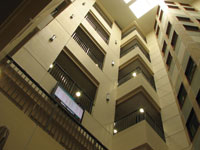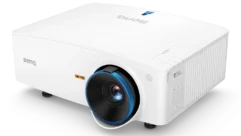

Big Board
Jun 9, 2009 1:43 PM,
By Dan Daley
Stetson University School of Business Administration students follow the market via an innovative digital signage system
Having today’s business information constantly at hand creates context for the business students at Stetson University’s School of Business Administration in DeLand, Fla. They have that information courtesy of a multiscreen digital signage system visible thoughout the school’s building.
Many folks these days are avoiding checking their retirement portfolios altogether, given the difficult economic environment, but for students still learning the ins and outs of what it takes to have a career in business and finance, having today’s business information constantly at hand creates context for their ambitions. That capability is what students at Stetson University’s School of Business Administration in DeLand, Fla., literally have at their fingertips. They have that information courtesy of a multiscreen digital signage system that is built on the foundation of a pair of Sharp PN-G655U 65in. HD LCD displays mounted in the building’s four-story atrium and five LG M3201C-BA 32in. LCD widescreen HD monitors positioned strategically throughout the building to compensate for the spots where the main displays can’t be seen, such as near the elevator banks.
The digital signage system’s genesis was the multimillion-dollar equities and bond portfolio amassed and managed by the business school’s students using a financial information feed from Rise Vision’s Rise Display Network that provides a customized feed on a near-realtime basis. Additionally, Wall Street stock information was already being displayed on a separate LED display system in the school’s mock trading room. Bringing it out into the public spaces of the building, however, gave all students a kind of emotional stake in what was happening in the market; it also acted as a marketing tool to prospective students touring the school—a visceral indicator that this is a business school that means business.
“When the content is compelling and tuned to what the environment and the audience want and need, digital signage has an enormous amount of power,” says Gerry Ewing, director of technical applications at Stetson University. Sitting in his office on the other side of the campus, Ewing can watch both the displays and the students’ reactions to them via an Axis 210 IP webcam mounted across from one of the two 65in. HD LCDs.
“Installing a multiscreen digital signage system as a
retrofit into an existing building is a challenge in and of itself,” he says. “But the technology is just the beginning. The real challenge in an environment like this—where the same people walk past the same screens day after day—is that the content has to be constantly but carefully refreshed regularly for it to be effective. You have no control over whether someone comes by a particular program at the beginning, the middle, or the end. The message has to be clear without being repetitive, or else the signage literally becomes invisible to people.”
Big Board
Jun 9, 2009 1:43 PM,
By Dan Daley
Stetson University School of Business Administration students follow the market via an innovative digital signage system

As pictured in this schematic, the digital signage system at Stetson University’s School of Business Administration is a complex system that ties together numerous sources that are all routed through a Kramer Electronics VP-724XL Proscale digital scaler/switcher and controlled by a Crestron Pro2 dual-bus control system. Click here to see a larger image.
It’s not just any audience either. Most of the eyes that will see the system’s content belong to the 18-to-24 college-age demographic—a group not known for long attention spans or toleration for less-than-slick production values. Ewing asked his media services group to design some of the system’s graphics, which are fed into the Scala InfoChannel Network Manager. A Scala ICD 3 Designer design station located across campus connects the Scala Network Manager to the digital signage system via IP.
“It’s got to be interesting, quick, and bold to capture this audience’s attention,” he says. “But it’s really the same for any digital signage situation: You have a very limited amount of time to get an entire message across, so you have to grab their attention fast.”
The affordable installation, which cost less than $100,000, broadcasts more than just financial data content and has numerous sources from which the system can draw content. Using Scala ICD 3 Designer software, content for the digital signage system is interspersed with text and video. The system is constantly refreshed for content including general campus announcements, upcoming events, calendars, information on course offerings, business faculty and administration profiles, emergency information if necessary, current date and weather, as well as streamed Wall Street news and stock-market information via a subscription from Rise Vision.
Sources include the Scala Player and Network Manager, a Denon DVD-2930CI progressive-scan DVD/CD player with HDMI output, and locally sourced HD cable, as well as a number of IP sources on several PCs, all routed through a Kramer Electronics VP-724XL Proscale digital scaler/switcher and controlled by a Crestron Pro2 dual-bus control system. Sources are automatically switched using Crestron’s RoomView software at the server. RoomView is programmed to turn the system on at 9 a.m. and off at 7 p.m. each day.
Muscle and finesse
Finding and creating compelling content may be hard, but as Ewing makes clear, installing a multipoint display system into an existing structure was complicated, to say the least. Among the challenges: locating existing conduit and trying to figure out which pathways would get them from the main tech closets on the first floor to the IT closet on the second floor where the Scala DSP was located, and then to the various display locations.
Big Board
Jun 9, 2009 1:43 PM,
By Dan Daley
Stetson University School of Business Administration students follow the market via an innovative digital signage system
“We worked closely with their IT people, who had a pretty good idea of which conduits went where, but there was still a lot of trial and error until we saw the snakes coming out the right places,” says Damon Wight, systems integration engineer for LMG, the Orlando-based company that did the installation and integration work on the project. The conduit pipe was fairly commodious, about 4in., but that advantage was offset by the maze of the building’s Ethernet conduit and the length of some of the home runs up the four-story atrium—the longest of which Wight estimates at about 150ft.
Optimum placement of the displays was achieved by mocking up cardboard cutouts of the same dimensions as the LCD screens, temporarily tacking them up, and then walking around and noting the best angles.
“We did that before issuing the purchase order for the screens,” Ewing says. “That not only saved time and effort, but it was the kind of touch that helped us get the funding approved for this in the first place.”
Putting the real thing in place, though, proved more challenging. It was decided that, for safety reasons, the 130lb. Sharp displays should be bolt-anchored to the structural I-beams within the balconies around the center atrium. First, two Sharp 65in. PN-G655U plasma/LCD wall mounts were installed by drilling through the drywall and then on into the I-beam. Because of a substantial air gap between the two, installers had to use the longest bits they had, and in the process, they burned out more than one. To thread the nuts onto the bolts, they had to punch a hole in the opposing classroom wall, as well as reach down through the ceiling tiles that covered both spaces.
Once the mounts were in place, the screens went up. The highest would be placed at about 25ft. off the ground using a pair of one-man hydraulic lifts, one on either side of the screen.
“We held the screen with one hand and controlled the lift with the other,” Wight says. He says this was probably the single most daunting challenge of the entire project—manipulating both the lifts and the heavy screens until they lined up perfectly with the mounting points. “It was a combination of finesse and muscle,” he says.
Interestingly, there is no audio in this digital signage installation. Ewing says that the concern was that it could be distracting for those working in classrooms near the monitors and that the hard-sided walls of the atrium would require significant acoustical treatment to keep the sound intelligible, thus raising the project’s cost. However, provisions were made for a line-level output at the head end on the second floor, which is where all the equipment is located and where the signal that is distributed to the displays throughout the building originates, for connection to powered loudspeakers.
The displays have become part of the landscape in the business school building, but the dynamic nature of the content never lets them fade into the background. And given the current situation in global stock markets, the students who have a stake in their collective school portfolio are probably checking these screens carefully each day.










